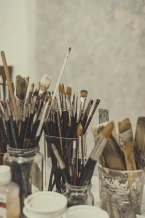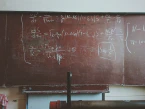Science Behind Creative Genius

The Remote Associations Test: Unlocking Your Ability to Connect Remotely Related Things
Have you ever played a game where you are given three unrelated words, and you have to come up with a fourth word that connects them all? This is called the remote associations test, and it is a fascinating way to measure your ability to see relationships between things that are only remotely associated.
In the video script, Michael and Jake from Vsauce1 and Vsauce3 play this game, with Michael giving three words and Jake coming up with a fourth word that links them together. For example, when Michael says “mouse, blue, sharp,” Jake replies with “danger.” While Michael was looking for “cheese,” Jake’s answer of “danger” is still semantically related to the three stimulus words.
This test is a powerful way to measure convergent thinking, which is the ability to find the single best solution to a problem. It requires you to think of the first word and cycle through all of the options for that word. Then, you move onto the second and third words, lining up which ones are consistent. Finally, you come up with the fourth word that fits all three words.
The remote associations test is just one type of creativity test, but it is a valuable tool for measuring your ability to think outside the box and make connections between seemingly unrelated things. By training your brain to see connections between remotely related things, you can unlock new possibilities and find innovative solutions to complex problems.
So, the next time you play a game of remote associations, remember that you are not just having fun – you are unlocking your creative potential and honing your ability to connect remotely related things.
Creativity Tests: Measuring Convergent and Divergent Thinking
Creativity is a complex and multifaceted concept, and measuring it is not easy. Creativity tests are used to measure both convergent thinking and divergent thinking, two different types of creative thinking.
Convergent thinking is the ability to find the single best solution to a problem. The remote associations test, mentioned in the previous section, is an example of a convergent thinking test. It requires you to find the one answer that best fits all three stimulus words.
On the other hand, divergent thinking is the ability to come up with multiple ideas and solutions to a problem. The Wallach-Cogan Creativity Test is an example of a divergent thinking test. In this test, you are asked to come up with as many items as possible that fit a specific component, such as naming all the things with wheels that you can think of.
In the video script, Michael and Jake play a game where they are asked to come up with as many ways as a cat and a mouse are similar. This task requires them to use divergent thinking and come up with multiple ideas and solutions.
Measuring creativity is not an exact science, and there is no one grand test of creativity. Instead, there are many different tests, each measuring a different aspect of creativity. The Torrance Test of Creative Thinking is the most widely used test for measuring creative potential, but it is not the only one.
By understanding the different types of creative thinking and the tests used to measure them, you can develop your creative skills and unlock your full potential. So, the next time you face a problem or challenge, remember to think both convergently and divergently, and you may be surprised at the innovative solutions you come up with.
The Torrance Test of Creative Thinking: Unlocking Your Creative Potential
The Torrance Test of Creative Thinking is the most widely used test for measuring creative potential. It was created in the 1960s by Ellis Paul Torrance, a psychologist and pioneer in the field of creativity research.
The Torrance Test is a group of tests that measures a person’s ability to think creatively and come up with innovative solutions to problems. It is used in 75% of creativity tests with children and about 40% of those with adults.
The Torrance Test consists of several subtests, each measuring a different aspect of creativity. One subtest asks you to complete an unfinished picture, while another asks you to come up with as many different uses for a brick as possible.
In the video script, Michael and Jake play a game where they are asked to make an object more fun by adding different elements like noise, bigger eyes, or even a video game. This task requires them to think creatively and come up with innovative ideas, much like the Torrance Test.
The Torrance Test is a valuable tool for measuring creative potential, but it is not without its limitations. It is just one type of creativity test, and there are many other tests that measure different aspects of creativity.
Nonetheless, the Torrance Test has stood the test of time and remains the most widely used test for measuring creative potential. By taking the test and understanding your strengths and weaknesses, you can develop your creative skills and unlock your full potential.
So, if you want to unlock your creative potential, consider taking the Torrance Test of Creative Thinking and see what innovative solutions you can come up with.
The 4 Elements of Measuring Divergent Thinking
Measuring divergent thinking, or the ability to generate multiple solutions to a problem, is a crucial part of measuring creativity. In the 1950s, psychologist Joy Paul Guilford introduced four elements to measure divergent thinking.
The first element is flexibility, or the ability to come up with responses in different categories. For example, if you were asked to name all the things with wheels, coming up with answers in categories like transportation, toys, or machines would demonstrate flexibility.
The second element is fluency, or the ability to generate a large number of responses. For example, if you were asked to come up with as many words as possible that start with the letter “B,” the number of words you generate would demonstrate your fluency.
The third element is originality, or the ability to generate unique responses. For example, if you were asked to come up with uses for a brick, coming up with a unique and creative use would demonstrate your originality.
The fourth element is elaboration, or the ability to add detail to your responses. For example, if you were asked to come up with uses for a brick, elaborating on how each use would work and why it would be effective would demonstrate your elaboration.
In the video script, Michael and Jake play a game where they are asked to name all the ways a cat and a mouse are similar. This task requires them to think divergently and come up with multiple solutions, demonstrating their flexibility and fluency.
Understanding the four elements of divergent thinking can help you measure and develop your own creative skills. By focusing on flexibility, fluency, originality, and elaboration, you can unlock your full potential and generate innovative solutions to problems.
Ways to Make an Object More Fun
In the video script, Michael and Jake play a game where they are asked to make an object more fun by adding different elements. This task requires them to think creatively and come up with innovative ideas to enhance the object’s appeal.
One way to make an object more fun is by adding noise. For example, adding a bell or a whistle to a toy can make it more interactive and engaging.
Another way to make an object more fun is by making its eyes bigger. This can make the object appear more cute or expressive, which can make it more appealing to children or adults alike.
Adding glitter or sparkles to an object is another way to make it more fun. This can make the object more visually appealing and add a touch of excitement to it.
Finally, adding a video game to an object can make it more interactive and engaging. This can turn a simple toy into a fun and challenging game that people of all ages can enjoy.
By using these and other creative strategies, you can make any object more fun and appealing. Whether you’re designing a toy, a game, or a piece of artwork, incorporating these elements can help you unlock your creativity and make something truly unique and enjoyable.
How to Get Education Without Schools
In the video script, Michael and Jake discuss how one can obtain an education without relying on traditional schooling. They suggest various ways that people can learn and expand their knowledge outside of the classroom.
One way to obtain education is by using online resources such as YouTube. With countless educational channels available, people can learn about virtually any subject they’re interested in. Whether it’s science, history, or art, there’s a wealth of knowledge available for free on the internet.
Another way to obtain education is by using libraries. Libraries are a great resource for finding books, magazines, and other materials on various subjects. By spending time in the library, people can immerse themselves in a subject and gain a deeper understanding of it.
Talking to old people is another way to obtain education. Older individuals have a wealth of life experience and knowledge that they can share with others. By talking to them, younger people can learn from their experiences and gain a unique perspective on the world.
By using these and other non-traditional methods, people can obtain education and expand their knowledge in new and exciting ways. Whether you’re a student, a professional, or simply someone who wants to learn more about the world, there are countless opportunities available to you outside of the classroom.
The Importance of Trial and Error in Learning
In the video script, Michael and Jake discuss the importance of trial and error in learning. They suggest that one of the best ways to learn is by making mistakes and learning from them.
Michael and Jake suggest that making mistakes can be a valuable learning experience. By trying new things and experimenting, people can learn what works and what doesn’t work. This approach can lead to a deeper understanding of a subject and can help people develop new skills.
One example of trial and error is when people are learning a new skill, such as playing a musical instrument. It takes time and practice to become proficient, and there will inevitably be mistakes along the way. However, by learning from those mistakes and continuing to practice, people can improve their skills and become more confident.
Michael and Jake also suggest that learning from mistakes can help people develop toughness. By accepting that mistakes are a natural part of the learning process, people can learn to hug failure and move past it. This can help them to become more resilient and better equipped to handle challenges in the future.
In conclusion, trial and error is an important part of the learning process. By hugging mistakes and using them as a learning experience, people can improve their skills, gain a deeper understanding of a subject, and develop toughness. Whether you’re learning a new skill, starting a new project, or simply trying something new, don’t be afraid to make mistakes and learn from them.
The Challenge of Finding the Grand Test of Creativity
In the video script, Michael and Jake discuss the challenge of finding the grand test of creativity. They explain that there is no one-size-fits-all approach to measuring creativity and that multiple tests are needed to measure different types of creativity.
Michael and Jake suggest that creativity can be measured in many different ways. For example, some tests measure convergent thinking, which is the ability to find a single correct answer to a problem. Other tests measure divergent thinking, which is the ability to generate multiple solutions to a problem.
The Torrance Test of Creative Thinking is the most widely used test for measuring creative potential. It includes several subtests that measure different aspects of creativity, such as fluency, flexibility, originality, and elaboration.
Despite the widespread use of creativity tests, Michael and Jake suggest that there is still no grand test of creativity. This is because creativity is a complex and multifaceted concept that can be difficult to measure. Different tests may be better suited to measuring different types of creativity, and it may be necessary to use multiple tests to get a complete picture.
In conclusion, measuring creativity is a complex task that requires multiple tests to measure different aspects of creativity. While the Torrance Test of Creative Thinking is the most widely used test for measuring creative potential, it is just one of many tests that can be used to measure creativity. As our understanding of creativity continues to evolve, new tests and approaches may emerge that will help us better understand this important concept.
Conclusion
In conclusion, creativity is a complex and multifaceted concept that can be measured through various tests. The remote associations test is one such test that measures the ability to see relationships between things that are only remotely associated. Meanwhile, creativity tests measure convergent and divergent thinking, which are crucial components of creative potential. The Torrance Test of Creative Thinking is the most widely used test for measuring creative potential, and it has been around since the 1960s.
Furthermore, divergent thinking tests are measured using four elements: flexibility, fluency, originality, and elaboration. Each of these elements contributes to a better understanding of an individual’s creative potential. It is essential to note that creativity can manifest in various ways and cannot be captured through a single test.
In addition, the challenge of finding the grand test of creativity persists. The search for a test that can accurately measure creativity in all its forms continues, and multiple tests are needed to measure different types of creativity.
Finally, the importance of trial and error in learning cannot be overstated. Learning through trial and error is a process that has been around for centuries, and it is still a vital aspect of acquiring knowledge. With the rise of technology and the internet, there are now many ways to access information and education without the traditional school system. From YouTube to libraries and talking to older people, there are numerous avenues to gain knowledge and expand creativity.
In conclusion, creativity is an integral part of human nature, and its importance cannot be overstated. While there is still much to learn about creativity and how to measure it, there is no denying its crucial role in shaping our world.











